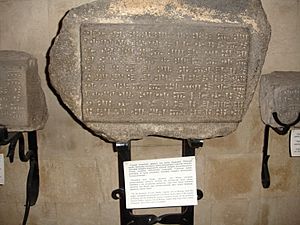Urartian language facts for kids
Quick facts for kids Urartian |
||||
|---|---|---|---|---|
| Vannic | ||||
| Native to | Armenian Highland | |||
| Region | Urartu | |||
| Era | attested 9th–6th century BCE | |||
| Language family |
Hurro-Urartian
|
|||
| Linguist List | xur | |||
|
||||

Urartian was an ancient language spoken by the people of the Urartu kingdom. This kingdom was located in what is now eastern Turkey, near Lake Van. The Urartian language was used from about the 9th to the 6th century BCE.
Contents
What is the Urartian Language?
The Urartian language is considered a "language isolate". This means it doesn't seem to be closely related to other major language families like Semitic (which includes Arabic and Hebrew) or Indo-European (which includes English and Spanish).
However, some experts believe Urartian was part of a smaller group called the Hurro-Urartian family. The only other known language in this family is Hurrian, which was spoken even earlier.
How Was Urartian Written?
The people of Urartu used a special writing system called cuneiform. This system used wedge-shaped marks pressed into clay tablets.
Cuneiform Writing
Most of what we know about Urartian comes from cuneiform inscriptions. These writings tell us about the history, laws, and daily life of the Urartian kingdom. Many of these texts were found on stone tablets or carved into rocks.
Hieroglyphs and Other Ideas
Some researchers think that the Urartu kingdom might have also used its own system of hieroglyphs. Hieroglyphs are pictures or symbols that represent words or sounds.
One Armenian scientist, Artak Movsisyan, has tried to understand these possible Urartian hieroglyphs. He suggested that they might be an early form of the Armenian language. However, this idea is still a hypothesis and needs more study.
See also
 In Spanish: Idioma urartiano para niños
In Spanish: Idioma urartiano para niños

